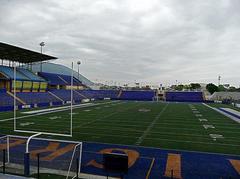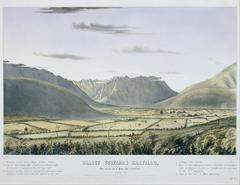
Talleres Monterrey, Mexico: Visiting Hours, Tickets, and Historical Sites Guide
Date: 04/07/2025
Introduction: Discovering Talleres and Its Industrial Legacy
Talleres, nestled in Monterrey’s industrial core, is a district rich with history and cultural significance. Its origins date back to the late 19th century, when it emerged as a central hub for railway workshops. The name “Talleres,” meaning “workshops” in Spanish, is emblematic of the area’s foundational role in supporting Monterrey’s transformation into the “Mexican Industrial Capital.” Here, visitors can trace the city’s journey from early railway expansion through the steel and metal fabrication boom, experiencing the vibrant community life that continues today. This guide offers an in-depth look at Talleres’ history, practical visitor information, and highlights must-see nearby attractions like Museo del Acero Horno 3 and Fundidora Park. For further context and travel guidance, consult resources such as Geo-Mexico, Mexico Newsletter, and Adventure Backpack.
Table of Contents
- Historical Development of Talleres in Monterrey
- Visiting Talleres: Practical Information
- Key Sites and Attractions Near Talleres
- Local Culture and Community
- Practical Tips for Tourists
- FAQ: Talleres Visiting Hours, Tickets, and More
- The Talleres Monument: Visitor Guide
- Visitor Attractions and Practical Information
Historical Development of Talleres in Monterrey
Origins and Early Growth
Talleres traces its roots to Monterrey’s late 19th-century industrialization, spurred by the arrival of the railway. The district was strategically established to house railway workshops crucial for maintaining locomotives and rolling stock, attracting skilled workers and fueling Monterrey’s emergence as a major manufacturing and transportation center (Geo-Mexico).
Industrial Expansion and the Steel Era
The early 20th century saw Monterrey’s industrial boom, with the founding of giants like Fundidora Monterrey—then the largest iron and steelworks in Latin America. Talleres grew alongside these enterprises, evolving into a dense hub for metal fabrication, machinery repair, and heavy industries. Its development paralleled the city’s diversification into cement, glass, petrochemicals, and food processing, solidifying Monterrey’s reputation in industrial circles (Mexico Newsletter).
Socioeconomic Impact and Urbanization
Industrial growth drew waves of migrants from across Mexico, shaping Talleres into a vibrant, multicultural working-class community. Low-income housing arose around the factories, while the city’s expansion attracted domestic and international corporations, including Cemex and FEMSA (Geo-Mexico).
Talleres and Monterrey’s Industrial Identity
Today, Talleres remains a symbol of Monterrey’s industrial character. Its landscape is a blend of preserved workshops, modern infrastructure, and community spaces. The district’s legacy is celebrated at museums like Museo del Acero Horno 3 in Fundidora Park, which offers interactive exhibits on steel production (Adventure Backpack).
Visiting Talleres: Practical Information
Talleres Visiting Hours and Tickets
Talleres, as a neighborhood, has no centralized visitor center or general admission. However, key nearby attractions have set hours and fees:
- Museo del Acero Horno 3: Open Tuesday to Sunday, 10:00 AM–6:00 PM; closed Mondays. Adult tickets are approximately 100 MXN, with discounts for students and seniors. Always check the official website for updated hours and prices.
- Fundidora Park: Open daily, 6:00 AM–9:00 PM. Entry is free, but some attractions inside require tickets.
Guided industrial heritage tours are available through local organizations and museums. Advance booking is recommended for these immersive experiences.
Accessibility
Talleres and its attractions are accessible via Monterrey Metro Line 1 (Talleres Station), bus lines, and ride-sharing services such as Uber and DiDi. Most museums and parks are wheelchair accessible, but verify specific access features before visiting.
Key Sites and Attractions Near Talleres
- Fundidora Park: A former steel foundry converted into a vast cultural and recreational park with museums, green spaces, and event venues (Monterrey Secreto).
- Macroplaza: One of the world’s largest public squares, featuring monuments, museums (Mexican History Museum, Museum of Contemporary Art), and gardens (Adventure Backpack).
- Barrio Antiguo: The city’s colonial quarter, known for its architecture, nightlife, and artisan markets (Monterrey Secreto).
Local Culture and Community
Talleres is proud of its working-class roots. Neighborhood markets, small eateries, and annual festivals create a lively atmosphere. Sample local specialties such as cabrito (roast goat) and machaca (dried beef) at traditional restaurants (Adventure Backpack).
Practical Tips for Tourists
- Getting There: Use Metro Line 1 (Talleres Station), buses, or ride-share apps. Parking is limited near industrial areas.
- Safety: Exercise standard urban caution, especially after dark. Stick to populated, well-lit areas (STR Specialist).
- Best Time to Visit: March–May and September–November offer mild weather and outdoor events (Best Time To).
- Events: Check local calendars for industrial heritage celebrations and community fairs (Traveler Bibles).
FAQ: Talleres Visiting Hours, Tickets, and More
Q: What are the visiting hours for Talleres?
A: The district itself has no set hours, but museums like Museo del Acero Horno 3 are open Tuesday to Sunday, 10 AM–6 PM.
Q: Is there an entrance fee to visit Talleres?
A: No, but museums and some attractions may charge admission.
Q: How do I get to Talleres?
A: Metro Line 1 (Talleres Station), buses, or ride-shares are recommended.
Q: Are guided tours available?
A: Yes, book in advance with museums or local organizations.
Q: Is Talleres accessible for families and people with disabilities?
A: Nearby attractions offer wheelchair access; always confirm in advance.
The Talleres Monument: Visitor Guide
History and Significance
The Talleres Monument is an emblem of Monterrey’s industrial spirit, dedicated to the city’s workers and its rise as a manufacturing center. Its design evokes industrial machinery, reflecting the area’s legacy as home to vital workshops.
Visiting Hours and Ticket Information
- Hours: Daily, 8:00 AM–8:00 PM.
- Admission: Free.
- Guided Tours: Free on weekends at 10:00 AM and 4:00 PM. For group or weekday tours, contact the Monterrey Tourism Office.
Getting There and Accessibility
- Access: Metro Line 1 (Talleres Station), buses, or ride-shares.
- Accessibility: Wheelchair-friendly pathways and ramps; parking available nearby.
What to See and Do
- Monument Features: Admire industrial-themed sculptures and plaques.
- Photography: Capture dramatic steel structures at sunrise or sunset.
- Nearby: Walk to Museo del Acero Horno 3 and Fundidora Park.
- Community Events: Attend Labor Day or local festivals held at the monument.
Tips for Visitors
- Best Time: Early morning or late afternoon for cooler weather.
- Safety: Visit during daylight for added security; use reliable transport.
- Essentials: Wear comfortable shoes, bring water, and use sun protection.
- Etiquette: Respect the site and local customs; photography is welcome, but avoid touching sculptures.
Major Attractions and Practical Information
Key Visitor Attractions
- Macroplaza: Open daily, dawn–dusk; free entry (PlanetWare).
- Barrio Antiguo: Galleries and shops open 10 AM–7 PM; free to enter (Mexico Travel & Leisure).
- Fundidora Park: 6 AM–10 PM daily; museums inside charge entry (PlanetWare).
- Santa Lucia Riverwalk: 7 AM–11 PM; boat rides ~MXN 50 (PlanetWare).
- Cerro de la Silla: No fee; best for morning or late afternoon hikes (PlanetWare).
Museums
- Museo de Historia Mexicana: Tues–Sun, 10 AM–6 PM, MXN 70.
- Museo del Acero Horno 3: Daily, 9 AM–6 PM, ~MXN 100.
- MARCO (Museo de Arte Contemporáneo): Tues–Sun, 10 AM–7 PM, ~MXN 70 (Audiala).
Markets and Shopping
- Mercado Juárez & Mercado Barrio Antiguo: Open 9 AM–8 PM; cash preferred (GoTravelTipster).
Events and Festivals
- Festival Internacional de Santa Lucía: Late August–early September.
- Tecate Pal Norte: Major music festival at Fundidora Park.
- Expo Manufactura: Industrial trade show at CINTERMEX (Trip.com).
Dining and Nightlife
- Traditional Dining: Try El Rey del Cabrito for local cuisine.
- Nightlife: Café Iguana and PRIDE Night Club are popular (Audiala).
Parks and Family Attractions
- Parque España: Free entry.
- Planetario Alfa: Tues–Sun, ~MXN 90 (Mexico Travel & Leisure).
- Grutas de García: 9 AM–5 PM, ~MXN 150.
Visitor Essentials
Getting There and Around
- By Air: Monterrey International Airport (MTY) is 20 km from downtown.
- By Road: Talleres is about 240 km from Laredo, Texas.
- Public Transport: Metro and bus systems operate from 5 AM to midnight; ride-shares are convenient (GoTravelTipster).
Accommodation
Options range from luxury hotels in San Pedro Garza García to budget hostels. Book early during event seasons (HowSafeIsMexico).
Safety and Local Customs
Stay in well-trafficked areas, use licensed transport, and secure valuables. Monterrey locals (“regios”) are friendly and welcoming (Audiala).
Weather and Best Time to Visit
The semi-arid climate brings hot summers and mild winters. The best months are October–April (Travel Mexico Solo).
Language and Communication
Spanish is the primary language; English is spoken in tourist spots (Audiala).
Money and Payments
Use Mexican pesos. Credit cards are widely accepted, but cash is needed at markets.
Health and Emergency Services
Modern medical care is available; dial 911 for emergencies.
Local Tips
- Dress casually; upscale venues prefer smart-casual.
- Tipping is customary (10–15%).
- Drink bottled water.
- Free Wi-Fi is common in public and hotel areas.
Unique Experiences
- Try a cabrito tasting tour or cooking class.
- Explore Barrio Antiguo’s street art.
- Enjoy live music at Café Iguana or PRIDE Night Club (Trip.com).
Accessibility
Most attractions and transit are accessible. Confirm details with venues ahead of your visit.
Frequently Asked Questions (FAQs)
Q: What are Macroplaza’s visiting hours?
A: Open daily from dawn to dusk; entry is free.
Q: Are tickets needed for Fundidora Park?
A: Park entry is free; museums inside charge admission.
Q: How do I get around Monterrey?
A: Metro, buses, and ride-share apps operate citywide.
Q: Is Monterrey safe for tourists?
A: Yes, especially in busy areas; use standard precautions.
Q: When should I visit Monterrey?
A: October–April for the best weather and festivals.
Summary and Final Tips
Talleres is a living testament to Monterrey’s industrial heritage, offering rich history, vibrant local culture, and access to some of the city’s top attractions. Explore the Talleres Monument, engage with the community, and discover the wider city through museums, parks, and culinary delights. Plan ahead using official tourism resources and apps like Audiala to make the most of your visit.
Useful Links and Resources
- Geo-Mexico
- Mexico Newsletter
- Adventure Backpack
- Monterrey Secreto
- STR Specialist
- Best Time To
- PlanetWare
- Mexico Travel & Leisure
- GoTravelTipster
- Trip.com
- Audiala Monterrey Guide
- Official Monterrey Tourism
- Museo del Acero Horno 3
- Fundidora Park




